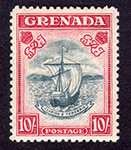
Grenada 10/ Issues
Updated - November, 2009



-
CW 22 / SG 163 Carmine & Slate-Blue Perforated 11.75 x 13 12,000 Printed Narrow 11/1937
-
CW 23 / SG 163a Carmine & Paler Slate-Blue Perforated 13.75 x 14.25 6,600 Printed Narrow 1/1938
-
CW 25 / SG 163b Rose-Carmine & Pale Blue-Grey Perforated 14 2,200 Printed Narrow 12/1942



-
CW 24 / SG 163c Deep Carmine & Black Perforated 11.75 780 Printed Narrow 2/1943
-
CW 26 / SG 163d Deep Lake & Pale Indigo Black Perforated 14 9,840 Printed Wide 8/1943
-
CW 26a / SG 163d Very Deep Claret & Blue-Black Perforated 14 Part of CW25a Printing Wide 8/1943



-
CW 25a / SG 163e Bright Rose-Carmine & Black Perforated 14 8,800 Printed Narrow 9/1943
-
CW 25c / SG 163e Carmine & Grey-Black Perforated 14 12,480 Printed Narrow 10/1944
-
CW 26b / SG163f Rose-Carmine & Black Perforated 14 29,400 Printed Wide 5/1947
The KGVI Grenada 10/ is one of the most interesting in the entire series of KGVI Stamps. There were eight printings over a period of ten years. In this series of stamps, you will find differences in perforation, color, the size of the image, the type of paper used, and the appearance of the center of the design. In order to determine the differences in these stamps, you will need a good perforation gauge, a clear ruler calibrated in millimeters, and sheets of white and black paper. I use the white or black paper as a backdrop when comparing stamps. The paper will help you observe differences in the color, gum, as well as characteristics of the paper while you are comparing multiple copies of this stamp. It is assumed that you have several copies, and are trying to sort them. Otherwise, this article will probably not be of much use to you.
The table above will give you an overview of this issue. The numbers in black are from the 2008 edition of the Commonwealth Catalogue and the 2008 edition of the Stanley Gibbons Catalogue. The colors are per Potter & Shelton's "The Printings of King George VI Colonial Stamps" which was published by Stamp Collecting, Ltd. in 1952. The dates and quantities are from Eric Yendall's "The Printings of the KGVI Grenada 10/" which appeared in Geosix 153, the September, 1989 issue of the King George VI Collectors' Society Newsletter. Please do not treat the photographs as totally accurate in terms of color. Internet Browsers do not clearly show the entire range of colors in the spectrum. Use the pictures as a comparison to known stamps in your collection. They will show the relative color differences in the stamps. If this seems confusing, don't give up. A verbal description of how to identify each issue follows. There are three sections, and the stamps from above will be redisplayed for your convenience on top of each section with the catalog numbers and perforation only.



-
CW 22 / SG 163 Perforated 11.8 x 13
-
CW 23 / SG 163a Perforated 13.75 x 14.25
-
CW 24 / SG 163c Perforated 11.75
The remaining six issues, which are all perforated 14, can be identified by comparing the width of the design, color, and gum. There are two different printing sizes which are referred to as narrow and wide. The size of the design is actually different. This was caused by the printing process. The narrow stamps measure 23.5mm from one side of the printed design to the other; and were printed on damp paper. The wide stamps measure 24.5mm from one side of the printed design to the other; were printed on dry paper. Details of this process may be found in Eric Yendall's article which was identified earlier.
The first step in sorting the stamps that are perforated 14 is to identify the narrow and wide printings. If you sort your stamps into piles of narrow and wide options, you can then proceed to the next step and compare the stamps of the same width.






If you only have a few copies of this stamp, and are unable to decide, I will guess that you have the common ones. Notice that of the 61,920 perf. 14 issues printed, 47% are CW-25C, and 20% are CW-26B. These two stamps are the ones you are most likely to find in an unsorted mixture. Good luck with sorting your stamps. Feel free to email with questions.
Addendum - This article was changed in May of 1999 based on input from Anthony Cole with advice from Dickon Pollard regarding the assignment of Gibbons Catalogue numbers compared to Commonwealth. There is still some argument in my mind about where CW 26 and CW25A belong relative to the Gibbons Catalog. However after some "cyber discussion" with my two advisors, here is where I think these stamps belong.
CW26 really looks nothing like either CW26B or CW26A but it can only be classified as either SG 163D or SG 163F due to the wide paper size. It is worth more than SG163F. Based on the Gibbons valuation, CW 26 should be considered to be SG163D.
CW25A looks more like the color described by Gibbons as SG 163B but is worth an amount closer to SG163E. Based on the Gibbons valuation, CW25A should be considered to be SG 163E.
You may order a copy of the new Commonwealth Catalogue from Murray Payne by using the Links to British Colonial Stamp Sites link below.